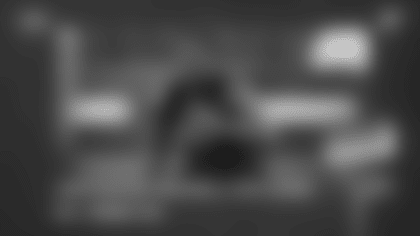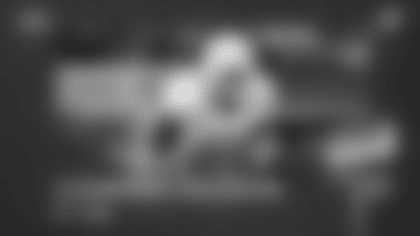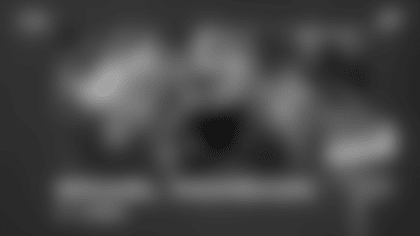
*
*
As we get closer and closer to the NFL Draft, a never-ending series of lists get posted by every football content provider under the sun ranking the top players at every position. Top 5 lists, mock drafts and big boards are all the rage this time of year. In this space, however, I want to look at these prospects a little differently.
So as April 30 approaches, let's take a look at these players from the mindset of how NFL franchises and scouting departments look at them and that's by figuring out how they fit on a football team, rather than just list the "Top 5 linebackers" or the "Top 10 wide receivers."
Think about the offensive line. You wouldn't just want to know about the top linemen in the draft. You'd want a list of the top tackles, the top guards and the top centers. All three positions typically have different measurables and responsibilities, so they should be categorized that way, right? And then the standards at each position change from team to team, as every franchise has certain needs and specifications for what they look for as they build their roster. Some teams prefer size and strength, others place value on athleticism and others just want tough guys at certain positions. So let's dig deeper, and look at some of the top players may fit once they find homes in the NFL ...
Of all positions in football, no group has historically been subgrouped in a traditional sense like the offensive line. Even the most casual football fan has a basic understanding of what a traditional left tackle, right tackle, guard and center bring to a team from a value standpoint. The left tackle is always the dancing bear with quick feet to protect the quarterback's blind side. The right tackle is the mauling road grader who you can run behind on every play. The guards are players who were too small or not athletic enough to play on the outside. The center has to be able to snap the ball to the quarterback. Do these types still hold true today? And are there other ways to think about the offensive line. I talked with former NFL offensive lineman (and Eagles Game Plan analyst) Ross Tucker about the different positions up front and how they fit in different schemes in the NFL.
Let's start first with a quick discussion on scheme fit. Typically, players get thrown into a box in terms of him being a "zone" lineman or a "power scheme" lineman depending on their skill set. If a guy showed the athletic traits for him to be effective on the move, he is seen by most as a "zone" lineman. If they're more of a big, physical, mauler at the point of attack, they're seen as more of a "gap" scheme lineman. The reality of it is, as Tucker explained, it's not that simple.
"I don't think that there's as much a difference (between zone and gap scheme linemen) as people probably think there is," Tucker said, "because there isn't a team in the NFL that doesn't run inside zone."
For an explanation on both types of running schemes and what it means for the ball carriers, here's my piece on the running back draft class.
"If you're a team that runs more gap schemes, you're typically going to have bigger, thicker, more powerful guys. That's just the nature of it," Tucker said. "They don't necessarily need to be as agile or as quick, but they need to be more powerful. If you're a team that runs a lot of outside zone (or other perimeter runs), you're going to want guys that are athletic and can really run because a lot of those blocks that are required, especially on the back side, require you to be very quick off the snap and ask for you to run laterally really quickly. So you'll see guys that are more fits for a zone scheme or more fit for a gap scheme, but I don't think that the difference is as big as some people may make it."
This is a valid point, and for proof look no further than a team like the Baltimore Ravens, who have one of the biggest lines in the NFL. They ran behind that line utilizing a zone blocking scheme with Justin Forsett all the way to the playoffs last year. San Francisco has had a ton of success running zone schemes with bigger linemen like Mike Iupati on the interior for years. Travis Frederick wasn’t considered by many to be a standout zone lineman coming out of Wisconsin, but the Dallas outside zone rushing attack led the NFL in yards rushing last year. There are always going to be outliers on either side, but big, powerful players can be effective in a zone scheme, just like more athletic lineman can be effective in a power scheme.
With all that behind us, let's look at this from a position by position standpoint.
When you look at offensive line prospects, everyone wants to immediately place them into a box.
"That guy is a left tackle."
"He could be a good tackle, but he'll be an All-Pro guard."
"This guy screams right tackle."
Realistically, though, where a prospect plays ultimately comes down to where he lands.
Lane Johnson was viewed as a top-level left tackle prospect coming out of Oklahoma, but he's been a starter at right tackle the past two seasons. Is that because he can't play on the left side? Of course not. But he arrived in a situation where all-world cornerstone Jason Peters resided, so moving to the right side was necessary for him to get in the starting lineup. You can look around the NFL for very similar situations. Greg Robinson was the second-overall pick in the draft last year and played multiple games at left guard this past fall. Riley Reiff has been a starter for the Lions at left tackle after he was tabbed as a right tackle or guard coming out of Iowa a couple of years ago. Peter Konz was the top-rated center by most in the 2012 NFL Draft, but he went to Atlanta and began his career at left guard. The list goes on and on, but the point remains. Listing these guys solely by position may not be the best way to categorize them.
How should these players be categorized? Let's start with body types. Everyone has a pretty good idea of what you want in an NFL tackle. He has to be big, at least 6-4 and at a minimum 300 pounds. He's got to have long arms. Once you get down to close to 33 inches, some teams start eliminating players from the tackle spot, although there are some who have played in the league at close to that mark of late. He's got to have great feet to protect the edge against speed rushers.
But what about the "left tackle vs. right tackle" stereotype? Doesn't one have to be a great pass protector and the other a great run blocker? I would argue that is an archaic way of looking at things with how today's game is played, and Tucker agreed.
"You look and see the number of really good rushers coming from the right side and you realize that's a pretty outdated way of thinking," Tucker said. "When you're looking at a guy and say, 'he's a textbook right tackle' what you're really saying is that he's not good enough in pass protection to play left tackle. If that's the case, then why would you want to put him up against guys like Connor Barwin, Von Miller or Justin Houston, who all rush from the right side. You need to have a pass blocker on both sides now."
With the difference between left tackle and right tackle being near nonexistent, here's how I categorize these players.
Tackle/Guard Prospects
Let's start with Iowa's Brandon Scherff. At 6-4, 319 pounds, the former Hawkeye has long been tabbed as the top lineman in the draft class, but there is a lot of debate about what his future position will be. Is he a left tackle? Is he a right tackle? Is he a guard? Different teams with different needs will see him any number of ways, but regardless of where he plays at the next level the team that gets him is getting a big, physical mauler up front who has the combination of power and lateral quickness to be effective in any run scheme.
In the shot above (courtesy of NFL.com), Scherff pulls left from the left tackle spot (No. 68), locates and strike a moving target on a touchdown run for Iowa. Some have questioned Scherff's foot quickness and point to the likelihood of him sliding inside in the NFL like Zack Martin did a year ago for the Dallas Cowboys, and that may be the case, but as Greg Cosell noted in our Film Room segment breaking down the offensive line class, there are a lot of quality starting tackles in the NFL who weren't seen as prototypical left tackles coming out of college. Scherff could be one of those guys.
The idea that you can "just simply" slide a player who has lined up at tackle throughout his career inside to guard is an idea that gets tossed around a lot this time of year. But that transition isn't the smoothest one to make. Tucker explained that he had been around a number of situations throughout his NFL career where the coaching staff attempted to transition tackles inside to guard, and while some worked, others were "unmitigated disasters."
"When you're talking about moving a left tackle over to the right side, it's an easier move to make," Tucker explained. "You're still going against the same body types, the timing is the same, you're just in a different stance and you have to get used to being in that stance. If you move inside, you're going to be asked to make different blocks and you're being asked to go against different body types and things move a lot faster."
Again, this transition may work for some, but for others it can be very tough. One prospect who likely won't have to face that transition inside is Andrus Peat from Stanford. Standing at nearly 6-7 and weighing a lean 313 pounds, the former five-star high school recruit is viewed as a physical, high-upside pass protector who, with technique refinement, can develop into the best tackle in this draft class.
On this clip (courtesy of NFL.com), you can see the power Peat possesses, as he drives an opposing defender into the ground on the move. At his height, however, sliding inside to guard may be more difficult.
"A lot of times (guards) are blocking guys that are 6-1, 325 pounds, 6-2, 330 pounds, and it really just doesn't help you to be 6-7 inside, height is not really a desired commodity at guard."
Keep in mind, when you get to the sixth, seventh or eighth offensive linemen on a team, you want players with position versatility. As Tucker put it if you only play one spot, you better be REALLY good at that one spot.
One player who consistently gets "selected" by the Eagles in mock drafts is Oregon's Jake Fisher. He has plenty of position versatility having played both tackle spots as well as inside at guard during his career with the Ducks, and some see him as having the potential to play any of the five positions along the offensive line. By far the best athlete at the Combine among the offensive linemen, Fisher's fit seems to be in more of a zone scheme, but he plays with good enough technique in the run game that he has the ability to be effective on a gap scheme team as well.
LSU's La'El Collins is in the same boat as Fisher, having played both at tackle and at guard during his time in Baton Rouge. At 6-4, 305 pounds, Collins' build is similar to that of Cowboys' left tackle Tyron Smith coming out of USC. Collins' movement between the lines as well as his physical nature are reminiscent of the All-Pro to some degree. Various analysts have questioned Collins' feet in regards to whether or not he can stick at tackle, but his strong hands in the run game and natural athleticism may be too much for a team to pass up.
On this goal line play (courtesy of NFL.com), you can see Collins' brute strength and nasty demeanor on full display as he puts one defender on the ground and looks for another as LSU bowls in for the touchdown.
One of the most intriguing blockers in this class because of his physical tools is Pittsburgh's T.J. Clemmings. At 6-5, 309 pounds, the former New Jersey high school standout boasts NFL size, a huge wingspan and the size/athleticism combination that make scouts go ga ga. He's only played two years along the offensive line as he was a former defensive end recruit, so he's got a ways to go in terms of technique, but Clemmings potentially brings the total package as an offensive tackle and has the ability to play inside as well.
Wisconsin's Rob Havenstein, like Peat, may be a bit too tall to shift inside to guard (6-7, 321 pounds) at the next level, but he has the look of a tackle, and for you traditionalists out there, he looks like he was born to play on the right side. A true people-mover up front, Havenstein packs a punch in the run game and has good enough feet to protect the corner as a pass protector.
Considered by most to be the most athletic player at his position, Florida's D.J. Humphries didn't light the Combine on fire in terms of his test results, but the tape shows a player with rare movement for the position and an ability to get out to the perimeter and finish defenders in space. Seen as the top offensive line prospect in his high school class by most recruiting services just three years ago, the 21-year-old Humphries had some issues staying healthy during his career with the Gators, but for a team that values athleticism along the offensive line, he could be a good fit early on.
Miami left tackle Ereck Flowers' draft "stock" is all over the map. Some see a player who is a potential Top-15 pick at left tackle, while others see a guy destined to slide inside at the next level. Many people point to the Nebraska game and his bout with Randy Gregory as a reason why he won't be able to handle NFL edge rushers. I personally think his "disappointing" performance may be a bit overblown. Others see Flowers as a mold of clay who, if some basic technique issues can get fixed, can be a stud blindside protector built in the mold of a Trent Williams. Not many people move the way Flowers does at 6-6, 329 pounds, and he may have as high a ceiling as any tackle or guard in this draft.
Flowers' value has been a divisive topic in draft media circles, as has Texas A&M's Cedric Ogbuehi. Another player who has experience at both tackle spots as well as inside at guard, Ogbuehi has very clean feet in pass protection, has NFL size at 6-5, 306 pounds and his natural athleticism cannot be overlooked.
Here's a shot from a couple of years ago (courtesy of NFL.com), where Ogbuehi is lined up at right guard (No. 70). Ogbeuhi's positional versatility is one of his strong suits. He had an up and down senior season by most accounts, and a torn ACL suffered in December also clouds the picture a bit, but some see Ogbuehi as a first-round lock while others see him as possibly falling into day three.
Penn State's Donovan Smith is a big, powerful blocker who enjoys moving people at the point of attack and clearing holes in the run game.
There's a shot from the week of practice at the Senior Bowl, where Smith just abuses a defensive end in an inside run drill. A college tackle who has the flexibility to shift inside to guard, Smith has a huge frame and boasted impressive athletic numbers following the Combine and his Pro Day. With his size and strength, Smith could be a factor for a zone team or a gap scheme run game.
Colorado State left tackle Tyler Sambrailo has a background in the cold as a successful freestyle skier, but his competitive toughness, athleticism and heady play have a lot of people in draft circles feeling warm and fuzzy. With just 33 inch arms, many see Sambrailo as a guard-only prospect, but he showed the ability to be a competent tackle prospect at the Senior Bowl and his athletic numbers were also strong at the Combine. Whether it's at guard or tackle, the former Ram may be best cast on a team that gets their linemen out on the move.
Jamil Douglas from Arizona State intrigues people because of his ability to flash both power at the point of attack and natural athleticism. A weight room junkie with strong hands and physical tools to succeed in a zone or gap scheme, Douglas could play tackle or guard once he reaches the NFL.
A group of players built with very similar body types: West Virginia's Mark Glowinski, Missouri's Mitch Morse and Syracuse's Sean Hickey profile as smart, athletic technicians who may best fit inside at guard at the next level. They do possess the body types to be able to spot-start at tackle if their team is in a pinch. All three players sport impressive athletic measurables and bring a toughness aspect to the field that make them a potential fit in multiple schemes. In the same mold, Virginia Tech's Laurence Gibson and Kentucky's Darrian Miller both have great lateral quickness and movement skills, but both need a lot of work from a technique standpoint to take the next step as NFL prospects.
On the opposite end from a body-type and skill-set standpoint, Jeremiah Poutasi from Utah, Robert Myers from Tennessee State, Josue Matias from Florida State, Daryl Williams from Oklahoma and Terry Poole from San Diego State are big, tough, powerful linemen with the ability to get great movement at the point of attack in the run game. They all (aside from Matias) played tackle at the collegiate level, but many experts see them as potentially being better fits inside where they can engage stronger defensive tackles and be used as pullers on the move. For teams looking to beef up their rushing attack, these five players may fit the bill.
Lastly, one player flying under the radar due to injury concerns is N.C. State's Rob Crisp. At just under 6-7, 301 pounds, Crisp has a tackle frame, has played on both sides of the formation and plays a very polished game for a college prospect. A good athlete for his size, the major blemish on Crisp's scouting report comes on his medical history, where he's missed serious time thanks to head and tailbone injuries. If healthy, Crisp could be one of the steals of the draft class along the offensive line.
Guard/Center Prospects
These interior linemen may not have the ability to slide outside to tackle, but playing inside they bring their own set of skills that are important to offensive success. Tucker mentioned that things happen so much quicker inside, and with all of the different blitz packages, stunts and twists that NFL defenses present on a weekly basis, these players have to be quick thinkers so they can react and keep the quarterback or ball carrier upright. Complex schemes are very rare at the college level. Length is still a factor because you're still going to be tasked with defending pass rushers one-on-one (though it's a bit more rare for that to happen for a center), but you may be more likely to see a lineman with 32-inch arms be effective inside than you would out at tackle.
Leading off this list, I'll start with a pair of interesting cases in that they are former offensive tackles. Cam Erving from Florida State and Ali Marpet from tiny Hobart College in Western New York both played left tackle in college and are facing a transition inside at the next level.
Erving made the switch midseason last fall from the blind side to center because of inconsistent play in the middle of the Seminoles' offensive line, and he shined. Many saw him as having to make the transition anyway, so seeing him play at such a high level on the interior makes his transition even easier to the NFL. With great athletic traits and quick hands at the point of attack, Erving's floor is very high because in theory he could step in and play all five positions along the line, at the very least making him a valuable "swing" reserve off the bench.
Marpet dominated the D-III level, enough that he was named the Co-Offensive Player of the Year in the Liberty League in 2014 as a left tackle. He continued that level of play down at the Senior Bowl, where he more than held his own against a level of play that he never encountered before. A smart, athletic, competitive player, Marpet's quickness off the line may be his best attribute.
In this shot from the Senior Bowl, Marpet's lateral mobility is on display on this stretch run play as he's able to cut off the three-technique and get to the second level to help spring a long run.
Athleticism is a trait that Oregon's Hroniss Grasu brings to the table as well. A 52-game starter for the Ducks at center, some see him possibly bringing the value to play guard at the next level as well. A durable, technically sound lineman with the ability to handle everything thrown his way from a mental standpoint, he could be a fit for many schemes and start sooner rather than later.
A.J. Cann from South Carolina is another experienced starter (51 games for the Gamecocks) with a slightly different set of skills, as his game is predicated more on power and leverage as opposed to quickness and light feet. An immovable object in pass protection that's tough to move off his spot, the stout All-SEC player has a strong vice grip in the run game and is viewed as one of the "safer" offensive line prospects in the draft by many analysts.
You can see the contact power from Cann on this shot (courtesy of NFL.com), as he's able to shock the Auburn defender on impact and get some movement up front.
One of the standouts from the Senior Bowl week of practices, Duke guard Laken Tomlinson brings a lot of the traits that you would expect from a prototypical "power" lineman. He's strong, he's stout, he's got active hands and he's got the smarts and experience inside to be a long-time starter for whatever team he lands on.
Florida State's Tre Jackson was publicized as one of the top linemen in college football heading into his senior season. It wasn't all sunshine and rainbows for the former Seminole in 2014, but he still possesses NFL traits that teams will like and he enjoyed a solid week of practice at the Senior Bowl in January. Built low to the ground, Jackson has functional athleticism and looks to finish blocks consistently once he's engaged with defenders. Greg Cosell likes to say that competitiveness is one of the most important traits for linemen, especially on the interior, and Jackson certainly has that trait down pat.
Another player who had a good week at the Senior Bowl, Florida's Max Garcia has good size for a center at 6-4, 309 pounds, but has experience playing both guard and tackle as well, so like Erving he brings the added versatility value as well. A strong technician with the toughness you want at the point of attack, Garcia could fit for a number of different teams. Garcia was a late addition to the Senior Bowl roster. The widespread belief was that he replaced Boston College's Andy Gallik, who missed the week of practice due to injury. Gallik is a bit squattier than Garcia at 6-2, 306 pounds, but moves very well laterally and displays great toughness in the run game that you look for from an interior lineman.
One player who stood out at the Senior Bowl but failed to earn an invite to the Scouting Combine is Georgia Tech guard Shaq Mason. Coming from that triple-option offense, Mason had to prove that he could execute even the simplest of basic pass sets at the week of practice. Coming out of that offense, though, he showed the ability to operate on the move as a run blocker and execute schemes very similar to what you would see from a zone run team in the NFL.
This is a stretch run play from the South squad at the Senior Bowl game. As a backside guard, Mason is asked to scoop the nose tackle, a task he executes to perfection. Mason's lateral movement is certainly his biggest strength, and something that should endear him to teams that utilize zone runs.
At the East-West Shrine Game, one of the most talked about players was Louisville guard John Miller. A big, strong, tough kid who plays with a nasty demeanor, Miller gets great movement off the snap in the run game and holds up well in pass protection because of his strong lower half. He and Kansas State center B.J. Finney were the standouts along the offensive line and should be drafted in the mid-to-late rounds of the draft.
Offensive linemen are built in a number of different ways, and their physical skill sets on the field may make them better fits for some teams than others. Yes, the extremely athletic linemen are likely best fit for a zone team, and the extremely powerful are likely best fit for a gap scheme team, but that grey area is a lot wider than people think. Remember, position versatility equates to value when you're talking about the sixth, seventh, and eighth linemen coming off the bench on gameday.
Fran Duffy is the producer of "Eagles Game Plan" which can be seen on Saturdays during the season. Be sure to also check out the "Eagle Eye In The Sky" podcast on the Philadelphia Eagles podcast channel on iTunes. Prior to joining the Eagles in 2011, Duffy was the head video coordinator for the Temple University Football team under former head coach Al Golden. In that role, he spent thousands of hours shooting, logging and assisting with the breakdown of the All-22 film from the team's games, practices and opponents. !























